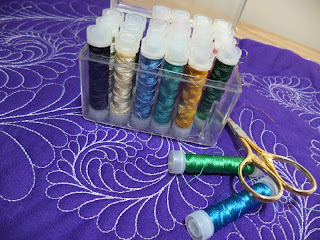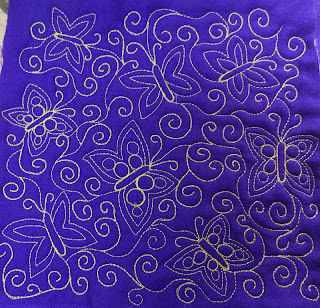When I was doodling around on the machine, trying to plan the quilting for Tree #2, I came up with this design that I'm calling Field of Butterflies. It uses
Cucumber Vine, from the Freemotion Quilting Project, to connect the butterflies.
Here's how to quilt Field of Butterflies:
Step 1. Begin with a few swirls of Cucumber Vine
Step 2. Add a short, gently waving line. Angle away from the work you've already done, into a relatively open area. This gives you space to form the first butterfly.
Step 3: Then, add 2 antennae. This is important- angle the antennae back toward the line you just made. This leaves the area in front of the needle open for the butterfly. This is the one step that is really different from how we usually do Cucumber Vine, but it is important to give yourself enough room for the next step.
Step 4. Form a long, narrow oval. This is the butterfly's body.
Step 4. Make the wings. Make the top and bottom wing on one side of the body, travel stitch a short distance at the bottom along the oval, then form the wings at the other side of the body. You will end at the top, or at the "head" of the butterfly.
Step 5: Fill inside the wings. You can echo inside the existing wing shape, like I did here.
Or, add 2 pebbles to each wing. I think it looks nice to taper the pebbles, by making a smaller one near the tip of each wing. Then, I like to echo around the wing.
Step 6: Use cucumber vine to move through your quilting space. Wherever you ended up in step 5, travel down the butterfly body so that your Cucumber Vine comes out from the bottom of the butterfly, at the opposite end from where you started. This is not really essential, but to me it is easier to evenly cover a space if I consistently end each butterfly at the bottom.
That's all there is to it! You are ready to add your next butterfly. I think this would be a very pretty design on a quilt for a little girl. Or on a pieced or appliqued butterfly quilt.
This is my first stab at writing a tutorial, so please let me know if you have any questions, or if anything is unclear!
I'm linking up to
FMQ Friday.
























































